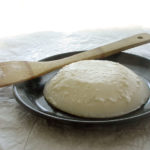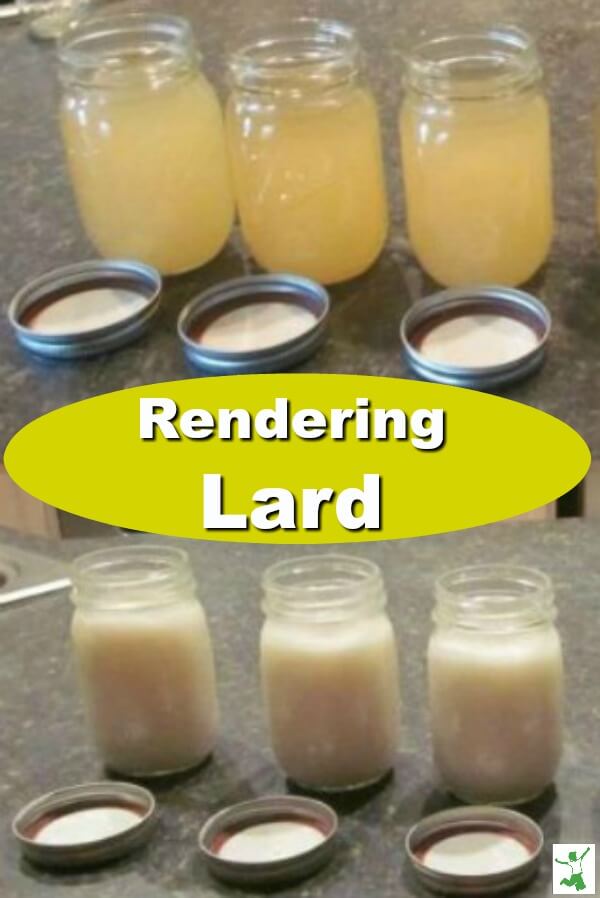Easy method to render pastured lard at home as a traditional way to add a healthy fat loaded with Vitamin D to your family’s diet.
More people are waking up to the old-time notion of how cost-effective and healthy it is to render lard.
Yes, lard!
Lard is a healthy, traditional fat from pigs that can be used to greatly enhance the flavor and nutrition of your home cooking and baking. Contrary to popular belief, lard does not make you fat. Perhaps the fact that lard is traditionally used for making pie crusts and eating too much pie will indeed make you fat is where the negative connotation comes from.
Animal fats such as chicken, goose, duck, tallow, and lard have nourished Traditional Cultures for centuries. The key is to source quality from healthy animals living in their natural environment outside.
The most nutritious and best quality lard is leaf lard, which is the fat around a pig’s kidneys. It is best to render lard once you have located a quality, pastured pig farmer in your local area. Lard contains high amounts of vitamin D when the pigs are allowed to be outside in the sunlight. Locating a source for pastured pork, then, is of primary importance to make sure you render lard of high nutritional quality.
The pork “cracklings” that are left over after rendering the lard can be placed on a cookie sheet in a warm oven overnight to dry out. They make a great snack alone or topping for salads!
Lard: A Healthy Fat Used for Millennia
Most people don’t realize that McDonald’s used beef tallow, which is very similar to lard, to fry its french fries. This all changed about 30 years ago in favor of partially hydrogenated fats which caused the unfortunate switch to these very unhealthy Factory Fats!
When I render lard, I freeze it in one-quart containers for easy storage and convenient access for cooking. One pound of leaf lard will render approximately 1 pint of lard.
Animal fat imparts valuable nutrition and wonderful flavor to roast vegetables. The reason many kids won’t eat veggies is that they are so tasteless! Roasting organic vegetables in a bit of chicken fat makes them absolutely delicious. My kids frequently ask why the veggies in restaurants are so tasteless and why the ones cooked at home are so yummy. Now you know the secret that Traditional Cultures always practiced!
Don’t Want to Make Lard?
If you decide making lard is not for you, fear not! You can buy pastured, premium leaf or pure lard. This is my preferred source.
This is a really awesome turn of events in recent years. It used to be only 10 years ago or so that you couldn’t buy unprocessed lard. You had to make it if you wanted to use it in your kitchen. Take advantage if time constraints are an issue for you in pursuing a Traditional Diet.
Beware of buying lard that isn’t a vetted source, as I’ve seen several brands in stores and online that hydrogenate the lard before packaging.

How to Render Lard
The traditional steps to render pastured lard yourself at home.
Ingredients
- 3 pounds leaf lard preferably pastured
- filtered water
Instructions
-
Remove leaf lard from the freezer. Cut up into cube like pieces.
-
Put all of the cubes of lard in a large stockpot. Add a half cup or so of filtered water to the pot so that the lard doesn't scorch or burn once you start rendering it.
-
Put pot on the stove with the cover off and turn the heat to medium to low. Stir the lard every five minutes or so as it is warming up and melting.
-
It will take quite a bit of time for the lard to completely melt and separate from the cracklings which will come to the top with the liquid lard in the bottom.
-
Strain the liquified lard through a strainer lined with a cheescloth and into a large bowl. Allow the lard to cool slightly and then pour into mason jars. Once at room temperature, screw on the lids and refrigerate. Freeze what you won't use in a few weeks.
-
The cracklings that are left in the strainer can be placed on a plate covered in a towel and left to air dry. They can be used as snacks or put on salads.
Recipe Video









Paula,
"All we need is LARD….da ta da da…All we need is LARD…."
I DO so agree – however I can't believe that you would know ANYTHING about menopause, you look 20 years old!!!! You are gorgeous!!! What is a wind sprint?
Sarah, you weren't supposed to tell!! Just kidding:) Anon, may I please help you "toss the clueless FDA"? I too wished I had discovered it years ago. Once I introduced lard and other animal fats into my diet and removed grains and refined carbohydrates I became leaner and saner. When I use lard, I get a warmth and saiety which makes me very happy. My rx for a smooth transition through menopause: Lard & Wind Sprints. Nothing like it–Praise the Lard!
I grind leaf lard in my meat grinder, then render it in my slow cooker. I usually set the crock pot outside on my back porch for the day to keep the heat out of the house. This process is much easier than rendering lard on the stove–I never have to stir.
Thanks for encouraging people to do this, and making it look easy, which it is! I rendered pastured leaf lard once and put it into sterilized canning jars that sealed tightly when they cooled. This was a bonus because I could store them in the cabinet rather than taking up freezer space. My slab of lard, about 10"x10"x3", rendered down into about five 16oz mason jars. My farmer said well-rendered lard lasts indefinitely in sealed jars in the cupboard or frozen in any type of jars. Once I open a jar, I store it in the frig and it lasts a long time (it's a very stable fat). I've been using this super duper fat for everything I can think of ever since. Eggs fried in lard slide right out of your stainless skillet. Ask your farmer to grind the fat, which makes it easier and faster to render (it took me about 2-3 hours total). Lard from pasture-raised pigs who are able to run around in the sun is one of the best sources of Vitamin D! I shudder to think of all the Crisco I consumed years ago, but it's better late than never to make this delicious and nutritious switch!
~Beth
Can you believe how gorgeous Paula looks in the video and she is 5-0! If that isn't a great commercial for eating pastured lard, I don't know what is!
So a pint really is a pound world round.
I’ve found that the more hog fat I eat the thinner I get! How FUN is that?! 🙂
Lard, butter, and coconut oil! At least a tablespoon of each a day, and I stay nice and trim. Whole fats are DEEE-LICIOUS, and there’s a reason for that!
Animal fat has been around a lot longer than the FDA. Why were they so quick to toss lard overboard? I personally think we should toss the clueless FDA!! When I discovered lard I wanted to hunt down the villains who'd kept me away from this beautiful stuff all these years!! Lard is my favorite fat for the kitchen, It is without a doubt the most sophisticated fat you will ever use. Everything turns out beautifully cooked, golden, yummylicious! Not flavored in anyway except the flavor of the actual food you are cooking.
I’ve rendered the fat in a crock pot on low and it does a very nice job without overheating the lovely fat, and doesn’t require as much babysitting. May you all bathe in the warm glow of hog fat!!!
Hello, for how long do I render the lard in a crockpot? And what canning jar seals tightly when they cool please? Thank you so much.
We are lucky: we just got 1/2 a pig from our farmer (pastured, of course, like all his animals!) and got the lard with it. The butcher even rendered it for us! 🙂 (Although I have rendered tallow before and would have done it myself if necessary.)
Thanks as always for making a potentially intimidating subject so accessible! You always make it look easy.